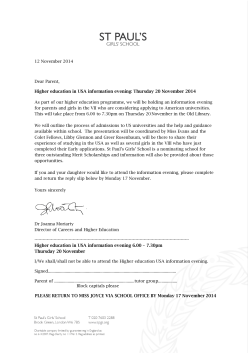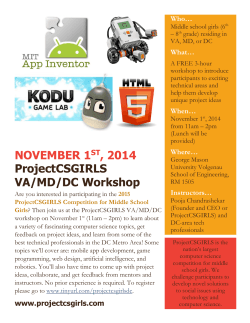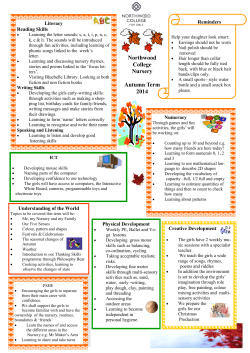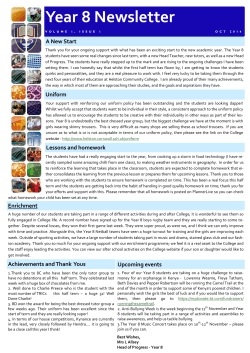
original article - journal of evolution of medical and dental sciences
DOI: 10.14260/jemds/2015/2 ORIGINAL ARTICLE ASSOCIATION OF ENERGY BALANCE AND PROTEIN INTAKE WITH NUTRITIONAL STATUS OF ADOLESCENT GIRLS IN A RURAL AREA OF HARYANA Seema Choudhary1, Neelu Saluja2, Seema Sharma3, Salil Dube4, S. M. Pandey5, Ajay Kumar6 HOW TO CITE THIS ARTICLE: Seema Choudhary, Neelu Saluja, Seema Sharma, Salil Dube, S. M. Pandey, Ajay Kumar. “Association of Energy Balance and Protein Intake with Nutritional Status of Adolescent Girls in a Rural Area of Haryana”. Journal of Evolution of Medical and Dental Sciences 2015; Vol. 4, Issue 01, January 01; Page: 6-11, DOI: 10.14260/jemds/2015/2 ABSTRACT: BACKGROUND: In spite of impressive gain in the field of health and nutrition, significant proportion of adolescent girls in our country is under-nourished. Often health and nutritional status of adolescent girls are direct reflection of the cumulative effects of various factors. One of the important parameters that causes under nutrition in adolescent girls is an increased risk of low protein and energy intake but high energy expenditure. Hence the problems related to adolescent girls deserve special attention. OBJECTIVE: (a) To assess nutritional status of study subjects, (b) To study energy balance and protein intake of adolescent girls in a rural area, (c) To find out the association of energy balance and protein intake with the nutritional status of adolescent girls. STUDY DESIGN: Community based cross-sectional study. SETTING: Primary Health Centre, Agroha, Haryana. PARTICIPANTS: 273 adolescent girls between 10-19 years of age. SAMPLE SIZE ESTIMATION: Based on the extent of under nutrition in adolescent girls. 39 adolescent girls were selected by simple random sampling from each of the 7 villages covered under PHC, Agroha. METHODS AND MATERIALS: The primary tools in this study were predesigned and pretested interview and examination schedule. Nutritional status of study subjects, was assessed on the basis of Body Mass Index (BMI). Their protein and energy intake was computed by 24 hours recall oral questionnaire method. Estimation of energy expenditure was based on physical activity which was noted by 24 hours activity recall questionnaire method. Energy balance of each subject was obtained by subtracting energy expenditure from energy intake. STATISTICAL ANALYSIS: Proportions and X2 test. RESULTS: Two third of the adolescent girls were under weight. Under-nutrition was 68.50% and 57.53% in subjects with negative and positive energy balance, respectively. There existed significant (P<0.01) association between protein intake and nutritional status of study subjects. CONCLUSIONS: In view of widespread under-nutrition in adolescent girls and it’s significant association with protein intake, it is imperative that nutrition education programmers, both in schools and at community be initiated through the existing rural networks including health services. KEYWORDS: BMI, Nutritional Status, Energy Balance, Protein Intake, Adolescent Girls. INTRODUCTION: Adolescence is a period of transition between childhood and adulthood that demands extra nutrients and energy dense food for rapid growth and maturation.1 Inadequate diet and unfavourable environmental condition in developing nations like India may adversely affect the growth and nutrition of adolescents. Malnutrition, both under nutrition and over nutrition, refers to an impairment of health, resulting from a deficiency or from an excess or imbalance of nutrients. It is of public health significance among adolescents across the world.2 The coexistence of overweight/obesity and underweight is rather common in developing countries and is found to be J of Evolution of Med and Dent Sci/ eISSN- 2278-4802, pISSN- 2278-4748/ Vol. 4/ Issue 01/Jan 01, 2015 Page 6 DOI: 10.14260/jemds/2015/2 ORIGINAL ARTICLE increased proportionally over time3,4. Several studies have investigated the nutritional status of children and adolescents from different parts of India.5,6,7 In spite of impressive gain in the field of health and nutrition, significant proportion of adolescent girls in our country is under-nourished. Often health and nutritional status of adolescent girls are direct reflection of the cumulative effects of various factors. One of the important parameter that causes under nutrition in adolescent girls is an increased risk of low protein and energy intake but high energy expenditure. High energy expenditure due to enhanced multiplicity of physical activities in terms of domestic, peri-domestic, low paid occupations and social activities forced them towards the negative energy balance. Which has profound adverse effect on their nutritional status? Various studies1,6,8 report that majority of rural adolescent girls suffer from chronic energy deficiency which jeopardize their nutritional status. But unfortunately, these aspects and precise estimates of under-nutrition of adolescent girls seem to receive little attention from any quarter especially in rural India. The present study is an attempt towards this direction. The specific objectives of the study were: (a) To assess nutritional status of study subjects, (b) To study energy balance and protein intake of adolescent girls in a rural area, (c) To find out the association of energy balance and protein intake with the nutritional status of adolescent girls. MATERIALS AND METHODS: The present cross-sectional study was carried out in Primary Health Training Centre (PHTC), Agroha, which is the Rural Field Training Centre attached to the Department of Community Medicine, Maharaja Agrasen Medical Institute of Education and Research, Agroha, Hisar (Haryana). The Primary Health Training Centre (PHTC), Agroha covers seven villages namely Agroha, Mirpur, Kuleri, Siwani Bolan, Saberwas, Khasa Mahajan & Fransi. The approach adopted for this community based study was cross sectional one. Sample size estimation was based on the extent of under nutrition in adolescent girls. As per literature search and a pilot study conducted in Agroha village, prevalence of malnutrition in rural adolescent girls ranged from 50-70% and thus taking a middle course a prevalence rate of 60% was assumed. By taking this prevalence and permissible level of error as 10%, sample size was computed. In all, 273 adolescent girls were enrolled for the study. To cover the desired sample size 39 adolescent girls were selected by simple random sampling from each of the 7 villages covered under PHC, Agroha. The primary tools in this study were predesigned and pretested interview and examination schedule for recording of family as well as individual information. Weighing machine (Libra) and steel anthropometric rod with parallel bars were utilized for weight and height recording respectively. Each study subject was subjected to anthropometry (weight & height recording) following standard technique.9 Nutritional status of study subjects, was assessed by body mass index. BMI of each study subject was computed by using the formula weight (kg)/ height (m2). Study subjects were graded in different grades of nutritional status according to proposed criteria for Asians.10 Dietary (protein and energy) intake of the study subjects was assessed by 24 hours recall oral questionnaire method. Standardized utensils were used for measuring the approximate intake of different food items, Dilution factor of liquid food was also noted. Diet survey was not conducted on day after any festival or any other special occasion. Their energy intakes were computed by referring to “Nutritive Value of Indian Foods”11 & “Nutritive Value of Common Indian Food”12 Calculations. J of Evolution of Med and Dent Sci/ eISSN- 2278-4802, pISSN- 2278-4748/ Vol. 4/ Issue 01/Jan 01, 2015 Page 7 DOI: 10.14260/jemds/2015/2 ORIGINAL ARTICLE Physical activity was noted by 24 hours activity recall questionnaires method. This served as basis for computation of energy expenditure. Energy expenditure of each study subjects was determined by multiplying their Basal Metabolic Rate (BMR) and rate of energy expenditure. BMR of study subjects was computed by taking into consideration of their body weight and using the formulae suggested by FAO/WHO/UNU13 consultation group. Utilizing the data on time spent on various activities (in minutes) and the corresponding multipliers,14,15 the rate of energy expenditure in terms of BMR units was found out mathematically. Where, ti is time spent (in minutes) for ith activity and mi is the corresponding multiplier. Energy balance of each subject was obtained by subtracting energy expenditure from energy intake. Data were analysed using appropriate statistical techniques viz. proportions and chi square test. RESULTS: As per Proposed Asian Criteria, two third (65.57%) adolescent girls were under weight (BMI<18.5). Nearly one third (29.67%) subjects suffered from chronic energy deficiency (CED) grade III (BMI<16). Only 29.30% study subjects had normal nutritional status; corresponding values for overweight (BMI 23-24.9) & obese (BMI >25) were 3.30% & 1.83% respectively (Table 1). Undernutrition was 68.50% and 57.53% in subjects with negative and positive energy balance, respectively (p>0.05)(Table 2). There existed significant (P<0.01) association between protein intake and nutritional status of study subjects (Table 3). DISCUSSION: Nutritional anthropometry predominates over the other methods of nutritional assessment. Several workers16,17 have emphasized the importance of Body Mass Index (BMI) as an index of nutritional assessment. The extent of under nutrition (BMI<18.5) in adolescent girls observed in this study was comparable with the findings of Choudhary et al8 (68.52%) & Deshmukh et al18 (53.8%) but greater than that reported by Singh et al19 (33.86%) and lower than that reported by Kalhan et al20 (80%). Variations in the extent of under-nutrition among adolescent girls could be attributed to differences in socio-cultural practices, level of socio-economic development, value attached to girl child and prevailing dietary practices in different settings. One third of the study subjects suffered from chronic energy deficiency grade III Similar findings was observed in another study8. Which reflects high degree of nutritional insult in adolescent girls? Thus the nutritional status of adolescent girls has been far from satisfactory which calls for urgent interventions at individual, family as well as community level (Table 1). Association of energy balance and nutritional status has been explored by some workers.21,22,23,24 In this study when the nutritional status of adolescent girls was assessed against their energy balance, it was evident that under-nutrition was higher in subjects with negative energy balance than those with positive balance. However, association was statistically not significant but J of Evolution of Med and Dent Sci/ eISSN- 2278-4802, pISSN- 2278-4748/ Vol. 4/ Issue 01/Jan 01, 2015 Page 8 DOI: 10.14260/jemds/2015/2 ORIGINAL ARTICLE role of negative energy balance in causation of under nutrition is well documented21,25 and this area needs to be explored in a longitudinal manner. (Table 2) One of the important parameter that determines nutritional status of an individual is protein consumption. In this study nutritional status of study subjects had been significantly influenced by their protein consumption. Almost similar results were observed in another study conducted in Uttar Pradesh.25 (Table 3) The effect of earlier insult of protein intake and energy balance is important parameters that cause under nutrition in adolescent girls particularly in rural areas. Further the cycle of poor nutrition perpetuates itself across generations particularly in girls aggravate this dismal situation. In general adolescent girls are the worst sufferers of the ravages of various forms of malnutrition. These are extremely important issues related to adolescent girls especially in rural areas when she is the foundation stone of the family in particular and society in general. CONCLUSION: Two third of study subjects were undernourished; nearly one third experiencing CED grade III. In view of widespread under-nutrition in adolescent girls and it’s significant association with protein intake, it is imperative that nutrition education programmers, both in schools and at community be initiated through the existing rural networks including health services. REFERENCES: 1. Anand K, Kant S, Kapoor SK. Nutritional status of adolescent school children in rural north India. Indian Pediatrics, 1999 Aug; 36: 810-815. 2. Mukhopadhyay A, Bhadra M, Bose K. Anthropometric assessment of nutritional status of adolescents of Kolkata, West Bengal. Journal of Human Ecology, 2005; 18 (3): 213–216. 3. Doak CM,. Adair LS, Monteiro C, Popkin BM. Overweight and underweight coexist within households in Brazil, China and Russia. Journal of Nutrition, 2000; 130 (12): 2965–2971. 4. Caballero B. The global epidemic of obesity: an overview. Epidemiologic Reviews, 2007; 29 (1): 1–5. 5. Kanade AN, Joshi SB, Rao S. Undernutrition and adolescent growth among rural Indian boys. Indian Pediatrics, 1999; 36 (2): 145–156. 6. Singh N, Mishra CP. Nutritional status of adolescent girls of a slum community of Varanasi. Indian journal of public health, 2001; 45 (4): 128–134. 7. Venkaiah K, Damayanti K, Nayak MU, Vijayaraghavan K. Diet and nutritional status of rural adolescents in India. European Journal of Clinical Nutrition, 2002; 56 (11): 1119–1125. 8. Choudhary Seema, Mishra CP, Shukla KP. Nutritional Status of adolescent girls in rural area of Varanasi. Indian J of Preventive and Social Medicine, 2003; 34 (1, 2): 56-61. 9. Jilliffe DB. The Assessment of Nutritional Status of the Community. World health Organization, Geneva, 1966; 7-233. 10. Joslin Diabetes Center. Best body mass for Asians (accessed at http:// www. joslin.harvard.edu/api/bodymass.html) 11. Gopalan C, Rama Sastri BV, Balasubramanian. Nutritive value of Indian foods.National Institute of Nutrition, ICMR, Hyderabad, 2000; 1-94. 12. Swaminathan M. Nutritive value of common Indian food calculations. Advanced text book on food and nutrition, 1995; 2: 42-51. J of Evolution of Med and Dent Sci/ eISSN- 2278-4802, pISSN- 2278-4748/ Vol. 4/ Issue 01/Jan 01, 2015 Page 9 DOI: 10.14260/jemds/2015/2 ORIGINAL ARTICLE 13. Food and Agriculture Organization / World Health Organization / United Nations University. Expert Consultation. Energy and Protein requirement. WHO Technical Report Series No. 724, Geneva 1985; 71-98. 14. Satyanarayana K, Venkata Raman Y, Rao MS, Anuradha A, Narasinga Rao BS. Quantitative assessment of physical activity and energy expenditure pattern among rural working women. Update Growth, 1987; 197-205. 15. ICMR. Nutrient requirements and recommended dietary allowances for Indians. A report of the expert group of the Indian Council of Medial Research, 1990; 11-27. 16. Cherian R. Rajasree S, Soman CR. Anthropometric assessment of malnutrition comparison of two age independent criteria. The Ind J Nut Diet, 1988; 25: 82. 17. Rao D. Hanumantha Nutrition Profile of Indian Tribes. Nutrition News published by National Institute of Nutrition, 1996; 17 (2): 1-6. 18. Deshmukh PR, Gupta SS, Bharambe MS. Nutritional status of adolescents in rural Wardha. Indian Journal of Pediatrics, 2006; 73 Feb: 139-141. 19. Singh MS, Neeta Devi RK. Nutritional status among the urban Meitei children and adolescents of Manipur, Northeast India. Journal of Anthropology, 2013 (2013). 20. Kalhan M, Vashisht B, Kumar V, Sharma S. Nutritional status of adolescent girls of rural Haryana. The Internet Journal of Epidemiology, 2009; 8 (1). 21. Choudhary Seema, Mishra CP, Shukla KP. Energy balance of adolescent girls In rural area of Varanasi. Indian Journal of Public Health, 2003; 47 (3): 21-28. 22. Alencar LE, Martiniz A, Fernandez C, Garaulet M, Perezllamas F, Zamora S. Dietary intake in adolescents with physical activity. Nutr Hosp, 2000 Mar-Apr; 15 (2): 51-57. 23. Cole AH, Taiwao OO, Nwagbora NI, Cole CE. Energy intakes, anthropometry and body composition of Nigerian adolescent girls. Br J Nutr., 1997 Apr; 77 (4): 497-509. 24. Burkey CS, Rockett HR, Field AE, Gillman MW, Fragier AL, Camargo CA Jr, Colditz GA. Activity, dietary intake and weight changes in a longitudinal study of preadolescent and adolescent boys and girls. Pediatrics 2000 Apr; 105 (4): 56. 25. Choudhary S, Mishra CP, Shukla KP. Correlates of Nutritional Status of Adolescent Girls in the Rural Area of Varanasi. The Internet Journal of Nutrition and Wellness, 2009; 7 (2). Sr. No. 1. 2. 3. 4. 5. 6. BMI (Kg/M2) < 16 16-16.9 17-18.4 18.5-22.9 23-24.9 ≥ 25 Total Number 81 46 52 80 9 5 273 Percentage 29.67 16.85 19.05 29.30 3.30 1.83 100 Table 1: Nutritional status of study subjects according to proposed Asian criteria (N=273) J of Evolution of Med and Dent Sci/ eISSN- 2278-4802, pISSN- 2278-4748/ Vol. 4/ Issue 01/Jan 01, 2015 Page 10 DOI: 10.14260/jemds/2015/2 ORIGINAL ARTICLE Energy balance Negative Positive Total BMI (Kg/M2) N < 16 16-18.4 18.5-22.9 23-24.9 X2 25 No. % No. % No. % No. % No. % 200 56 28.00 81 40.50 56 28.00 4 2.00 3 1.50 2.85 73 25 34.24 17 23.29 24 32.88 5 6.85 2 2.74 (df=1) 273 81 29.67 98 35.90 80 29.30 9 3.30 5 1.83 Table 2: Nutritional status of study subjects according to their energy Balance (N=273) P 0.091 Note: For computation of X2,BMI has been grouped into 2 categories i.e. < 18.5 and 18.5 kg/m2. Percent protein intake N 80 80.1-100 > 100 Total 146 87 40 273 <16 No. % 47 32.19 17 19.54 17 42.50 81 29.67 16-18.4 No. % 56 38.36 28 32.18 14 35.00 98 35.90 BMI (Kg/M2) 18.5-22.9 23-24.9 No. % No. % 38 26.03 3 2.05 35 40.23 5 5.75 7 17.50 1 2.50 80 29.30 9 3.30 25 No. % 2 1.37 2 2.30 1 2.50 5 1.83 X2 P 11.51 (df=2) 0.003 Table 3: Nutritional status of adolescent girls according to their protein intake (N=273) Note: For computation of X2, BMI has been grouped into 2 categories i.e. <18.5 and 18.5 kg/m2. AUTHORS: 1. Seema Choudhary 2. Neelu Saluja 3. Seema Sharma 4. Salil Dube 5. S. M. Pandey 6. Ajay Kumar PARTICULARS OF CONTRIBUTORS: 1. Professor, Department of Community Medicine, MAMC, Agroha, Hisar. 2. Associate Professor, Department of Community Medicine, MAMC, Agroha, Hisar. 3. Assistant Professor, Department of Community Medicine, MAMC, Agroha, Hisar. 4. 5. 6. Assistant Professor, Department of Community Medicine, MAMC, Agroha, Hisar. Assistant Professor, Department of Community Medicine, MAMC, Agroha, Hisar. Assistant Professor, Department of Physiology, MAMC, Agroha, Hisar. NAME ADDRESS EMAIL ID OF THE CORRESPONDING AUTHOR: Dr. Seema Choudhary, Professor, Department of Community Medicine, MAMC, Agroha, Hisar, Haryana-125047. E-mail: profseemachoudhary@yahoo.co.in Date of Submission: 18/12/2014. Date of Peer Review: 19/12/2014. Date of Acceptance: 23/12/2014. Date of Publishing: 30/12/2014. J of Evolution of Med and Dent Sci/ eISSN- 2278-4802, pISSN- 2278-4748/ Vol. 4/ Issue 01/Jan 01, 2015 Page 11
© Copyright 2025









